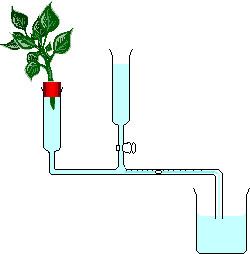 | ||
A potometer (from Greek ποτό = drunken, and μέτρο = measure) —sometimes known as a transpirometer— is a device used for measuring the rate of water uptake of a leafy shoot. The causes of water uptake are photosynthesis and transpiration. Everything must be completely water tight so that no leakage of water occurs.
Contents
There are two main types of potometers used - the bubble potometer (as detailed below), and the mass potometer. The mass potometer consists of a plant with its root submerged in a beaker. This beaker is then placed on a digital balance; readings can be made to determine the amount of water lost by the plant. The mass potometer measures the water lost through transpiration of the plant and not the water taken up by the plant.
1) Indirectly - by measuring the distance the water level drops in the graduated tube over a measured length of time. It is assumed that this is due to the cutting taking in water which in turn is necessary to replace an equal volume of water lost by transpiration. 2) Directly - by measuring the reduction in mass of the potometer over a period of time. Here it is assumed that any loss in mass is due to transpiration.
Design
Potometers come in a variety of designs, but all follow the same basic principle.
Preparation
- Cut a leafy shoot for a plant and plunge its base into water. This allows the xylem from taking up any air. Wetting the leaves themselves will alter the rate of transpiration.
- Immerse the whole of the potometer into the sink. Move it about until all the air bubbles come out.
- Recut the shoot's stem underwater. Put it into the bung; grease the bung with plenty of petroleum jelly (Vaseline) if it doesn't stay and then put the bung into the potometer.
- Make sure the tap is closed, then lift the whole assembly out of the water.
- Leave the end of the capillary tube out of the water until an air bubble forms then put the end into a beaker of water.
Types of Potometers
- Bubble Potometer
- Mass potometer
- Ganong's Potometer
- Darwin's Potometer
Use
- Set up the conditions of the experiment. Alterations to lighting (placing the plant in bright light or shadow), wind (directing a fan at the plant), and humidity (placing the plant in a humid chamber) are typical.
- Let the bubble reach a "zero" point in the tube.
- Measure the movement of the bubble at regular intervals and record the results
Precautions
- When a twig is cut from a plant, it should be immediately put under water (only the cut portion). Then, a small part is cut under water. This prevents entry of air into the xylem vessels.
- The conditions of the potometer, other than the alteration that is being tested, should not be changed during a test, as outside conditions (for example, temperature) determine water uptake.
Limitations
- The Potometer does not measure the rate of transpiration accurately because not all of the water that is taken by the plant is used for transpiration (water taken might be used for photosynthesis or by the cells to maintain turgidity). The potometer measures the rate of uptake of water. To measure transpiration rate directly, rather than the rate of water uptake, utilize a scientific instrument which quantifies water transfer at the leaves.
- A twig may not be active for a long time.
